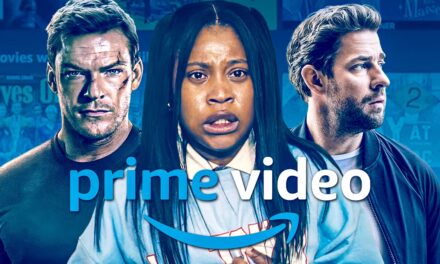Edward G Robinson’s gangster Johnny Rocco in Key Largo (John Huston, 1948) seems uncertain when asked by Humphrey Bogart and Lionel Barrymore’s sequestered characters what he wants. But after some prompting, he comes up with ‘That’s it. I want more.’ Mindless acquisitiveness matches his mendacity and violence.
And that’s the story with the discreditable alliance between pro sports and the screen. Let’s consider some numbers and history, culminating in the environmental implications of the current conjuncture’s destructive shift from broadcast and cable TV coverage to streaming.
The last twenty-five years have seen significant struggles between different factions of capital to obtain consumer subscriptions for broadband, cable, satellite, telephony, and wifi. Sports became part of this conflict as coverage slipped away from broadcast, free-to-air television. Rupert Murdoch notoriously, indecorously said his companies ‘use sports as a ‘battering ram” to obtain subscribers (quoted in Milliken, 1996). In the late 1990s, France’s Canal+ estimated that 40% of its audience signed on just to watch football (Williams 1998: M3; Williams 1999: 104). By 1999, this enticement saw the rights to cover European matches on TV cost over two billion dollars (Croci and Ammirante 1999: 500).
Today, the terrain has shifted. Newer online formations seek to attract young viewers with few affiliations to broadcasting or cable. In the embarrassingly mindless metaphors deployed by the industry, a ‘full funnel approach’ claims the ‘ability to drive right through to commerce’ (quoted in Weprin, 2024). Amazon is taking advantage of commercial TV’s loss of advertising revenue to buy sports rights at depressed prices. It plans to draw subscribers to Prime both to watch and buy goods, while distracting attention from its labor practices and ecological record and gaining general goodwill (Hutchins et al., 2019; Poindexter, 2021). Streamers have become partners with cable sports networks to dominate how programs are watched online (Szalai, 2024). From the other direction, Warner Bros. Discovery, Disney, and Fox have plans to stream sports together (Steinberg, 2024). In place of Murdoch’s ‘battering ram,’ the new grotesque cliché is that sports provide the media with a ‘core competitive differentiation’ (Vernon et al., 2024).
Enabled by the Summer Olympics and football’s European Championships (the Euros), 2024 saw over sixty billion dollars expended on rights, up 12% on the previous year (SportBusiness, 2024). In the US, 16.5% went to streamers (Genovese, 2024), which spent ten billion worldwide on sports (Ampere 2025: 6). Apple TV purchased global coverage of Major League Soccer for a decade from 2023 at $250 million per year, matching its deals for Major League Baseball. Amazon Prime captured certain Yankees home games, NFL fixtures (for ten billion), and Europe’s Champions League, and announced emerging interests in motorsport and women’s basketball. Google bought Sunday NFL rights for fourteen billion from 2024. Netflix started League coverage that year, “wrestling” in 2025, and the women’s World Cup of football from 2027, investing five billion over a decade (Silverman and Ourand, 2022; Battaglio, 2022; Kafka, 2021; Weprin, 2021 and 2024; Germano et al., 2022; Porter, 2024). DAZN handed FIFA a billion euros to broadcast the inaugural Club World Cup in 2025 (“DAZN,” 2024). Formula One’s income from media rights grew 7.9% in 2024 to $1.18 billion as it sought to switch from US cable to streaming (Agini, 2025).
The implications for our environment are dire. For instance, 2021’s Super Bowl TV commercials produced two million tonnes of CO2 from 6.3 billion spectators—26 million online—and 64 billion references on “social” media. A million such impressions, as they are known, equate to a metric tonne of CO2 (L, 2024). Each minute a person uses TikTok, 2.63 grams of carbon are emitted (Musto, 2024). An hour of streaming to mobile gadgets requires more electricity than two new refrigerators (Mills, 2013). Even on standby, they exhaust hundreds of terawatt hours a year, equal to massive numbers of coal-fired power plants (International Energy Agency, 2014). People watching sports on these wee devices increase their footprint tenfold in comparison with television (Carbon Trust, 2013, n.d., and 2016; TePoel, 2017).
By 2023, the world’s data centers consumed as much electricity as Britain (“Can Computing,” 2023) and were responsible for 4.4% of overall US energy use (Shehabi et al., 2024). There are over ten thousand of these “clouds” across the globe, about half in the Americas, a third in Asia. They require around 55 gigawatts of energy and 300m square feet of land (“The Data-Centre,” 2025). They also need a lot of water—official disclosures indicate that the Google cloud used 21.198 million liters in 2022, an increase of 20% on 2021, and Microsoft’s 6.435 million, up 34% (Google, 2023; Microsoft, 2022). Apple, Meta, Google, and Microsoft understated their 2023 greenhouse-gas emissions by 662% (O’Brien, 2024). Google, Microsoft, and Apple are building dozens of data centers in parched areas of the world, denying local people much-needed reserves (Source Material, 2025).
TV studies needs to contribute to public/policy debates on sports rights, both in terms of the commodification of audiences and the fetish for growth per Johnny Rocco that is so destructive of our environment.
__________________________________________________________________________________________________________
References
“Can Computing Clean Up its Act?” (2023, August 16). Economist https://www.economist.com/science-and-technology/2023/08/16/can-computing-clean-up-its-act.
“DAZN Secures Exclusive Fifa Club World Cup Rights.” (2024, December 4). BBChttps://www.bbc.com/sport/football/articles/crl387gr18ro
“The Data-Centre Investment Spree.” (2025, February 5). Economisthttps://www.economist.com/business/2025/02/05/the-data-centre-investment-spree-shows-no-signs-of-stopping.
Agini, Samuel. (2025, March 15). “Formula 1 Owner Bets on Brad Pitt’s Pulling Power to Shift into US Mainstream.” Financial Times https://www.ft.com/content/61b0156f-0025-4f2b-8037-e7477c2e92c1?utm_source=semafor.
Ampere. (2025). A Year of Sport 2024: Full Stream Ahead in 2025 https://19957038.fs1.hubspotusercontent-na1.net/hubfs/19957038/2024%20in%20Sports-1.pdf?utm_medium=email&_hsenc=p2ANqtz-_dXEmIwhUZXNR8DZTyCGUGWDN8MjPoO5EcDUzk62EM2P1PCObUjAH9Y8GOaZ2ESRWnL-vWSERAUBeKBETg6joUvYAj0w&_hsmi=307835695&utm_content=307835695&utm_source=hs_automation.
Battaglio, Stephen. (2022, June 14). “Why Apple TV Has Become the Exclusive Streaming Home for Major League Soccer.” Los Angeles Times https://www.latimes.com/entertainment-arts/business/story/2022-06-14/apple-tv-will-become-the-exclusive-streaming-home-for-major-league-soccer.
Carbon Trust. (2013, August 9). “Carbon Trust Unlaces the ‘Carbon Bootprint’ of Watching Football.” https://www.carbontrust.com/news-and-insights/news/carbon-trust-unlaces-the-carbon-bootprint-of-watching-football.
Carbon Trust. (2016). The “Carbon Bootprint” of Euro 2016: Which Nation’s Fans Have the Lowest Carbon Footprint When Watching Games https://www.carbontrust.com/news/2016/06/the-carbon-bootprint-of-euro-2016-which-nations-fans-have-the-lowest-carbon-footprint-when-watching-games/.
Carbon Trust. (n.d.). Carbon Bootprint of the FA Community Shield https://www.carbontrust.com/media/360767/carbon-bootprint-infographic.pdf.
Croci, Osvaldo and Julian Ammirante. (1999). “Soccer in the Age of Globalization.” Peace Review 11, no. 4: 499-504.
Genovese, Jack. (2024, October 11). “Why Do US Sports Media Rights Keep Climbing?” SportsProhttps://www.sportspromedia.com/insights/opinions/sports-tv-rights-values-usa-nba-nfl-cfp-nhl-ampere-analysis-data/.
Germano, Sara, Anna Nicolaou, and Hannah Murphy. (2022, December 22). “Google Agrees NFL Streaming Deal as Big Tech Chases Sports Rights.” Irish Times https://www.irishtimes.com/business/2022/12/22/google-agrees-nfl-streaming-deal-as-big-tech-chases-sports-rights/.
Google. (2023). Environmental Report 2023 https://www.gstatic.com/gumdrop/sustainability/google-2023-environmental-report.pdf.
Hutchins, Brett, Bo Li, and David Rowe. (2019). “Over-the-Top Sport: Live Streaming Services, Changing Coverage Rights Markets, and the Growth of Media Sport Portals.” Media, Culture & Society 41, no. 7: 975-94.
International Energy Agency. (2014). More Data, Less Energy: Making Network Standby More Efficient in Billions of Connected Devices http://www.iea.org/publications/freepublications/publication/MoreDataLessEnergy.pdf.
Kafka, Peter. (2021, March 18). “Amazon’s $10 Billion NFL Deal is Huge—And a Sign That Sports is Staying on TV for a While Longer.” Vox https://www.vox.com/recode/22338794/amazon-nfl-10-billion-tv-analysis.
L, Jennifer. (2024, February 9). “Beyond Touchdowns and Trophies: Unveiling the Carbon Footprint of Superbowl LVIII.” Carbon Credits https://carboncredits.com/beyond-touchdowns-and-trophies-unveiling-the-carbon-footprint-of-superbowl-lviii/.
Microsoft. (2022). 2022 Environmental Sustainability Reporthttps://query.prod.cms.rt.microsoft.com/cms/api/am/binary/RW15mgm.
Milliken, Robert. (1996, October 15). “Sport is Murdoch’s ‘Battering Ram’ for Pay TV.” Independenthttps://www.independent.co.uk/sport/sport-is-murdoch-s-battering-ram-for-pay-tv-1358686.html.
Mills, Mark P. (2013). The Cloud Begins with Coal: Big Data, Big Networks, Big Infrastructure, and Big Power. National Mining Association and American Coalition for Clean Coal Electricity http://www.tech-pundit.com/wpcontent/uploads/2013/07/CloudBeginsWithCoal.pdf?c761ac.
Musto, Julia. (2024, October 29). “Every Email, TikTok and Text We Send is Killing the Environment. Here’s How.” Independent https://www.independent.co.uk/climate-change/email-tiktok-environment-climate-change-b2637645.html.
O’Brien, Isabel. (2024, September 15). “Data Center Emissions Likely 662% Higher Than Big Tech Claims. Can it Keep Up the Ruse?” Guardian https://www.theguardian.com/technology/2024/sep/15/data-center-gas-emissions-tech.
Poindexter, Owen. (2021, June 21). “Amazon’s Aggressive Expansion into Sports Continues.” Front Office Sportshttps://frontofficesports.com/amazon-wants-all-the-live-sports/.
Porter, Rick. (2024, January 23). “Ted Sarandos: WWE Deal Doesn’t Change Netflix’s Live Sports Stance.” Hollywood Reporter https://www.hollywoodreporter.com/business/business-news/netflix-wwe-deal-doesnt-change-live-sports-strategy-1235805365/.
Shehabi, Arman, Sarah Josephine Smith, Alex Hubbard, Alexander Newkirk, Nuoa Lei, Md AbuBakar Siddik, Billie Holecek, Jonathan G. Koomey, Eric R. Masanet, and Dale A. Sartor. (2024, December). 2024 United States Data Center Energy Usage Report https://eta.lbl.gov/publications/2024-lbnl-data-center-energy-usage-report.
Silverman, Alex and John Ourand. (2022, June 14). “MLS Goes with Apple in Landmark 10-Year Global Media Rights Deal.” Sports Business Journal https://www.sportsbusinessjournal.com/Daily/Issues/2022/06/14/Media/MLS-TV-rights.aspx.
Source Material. (2025, April 9). “Big Tech’s Data Centre Push Will Take Water from the World’s Driest Areas.” https://www.source-material.org/amazon-microsoft-google-trump-data-centres-water-use/.
SportBusiness. (2024). Global Media Report 2024 https://www.sportbusiness.com/global-media-report-2024/.
Steinberg, Brian. (2024, April 29). “Fox, Disney, Warner Will Tap Streaming Sports Venture in TV Upfront (EXCLUSIVE).” Variety https://variety.com/2024/tv/news/fox-disney-warner-tv-streaming-sports-venture-upfront-ad-sales-1235984530/.
Szalai, Georg. (2024, January 17). “Amazon to Buy Minority Stake in Diamond Sports, Sinclair to Pay $495M in Settlement.” Hollywood Reporter https://www.hollywoodreporter.com/business/business-news/amazon-diamond-sports-investment-reorganization-sinclair-settlement-1235790585/.
TePoel, Dain. (2017). “Digital Sport History, with Costs: An Ecocentric Critique.” Journal of Sport History 44, no. 2: 350-66.
Vernon, Jezz, Catherine Johnson, Joanne Evans, Rob Collier, Richard Ellis, Abhaya Sumanasena, Graham Mills, Awnit Kumar, Tim Jacks, Bertrand Moullier, and Alex Taylor. (2024). Future of TV Distribution: A Report Prepared by the University of Exeter with the University of Leeds, MTM, 3 Reasons and Real Wireless. Department for Culture, Media and Sport https://assets.publishing.service.gov.uk/media/672cafe262831268b0b1a2f4/Future_of_TV_Distribution_FINAL__7_Nov_2024_-accessible.pdf.
Weprin, Alex. (2021, August 11). “Sports Rights’ Streaming Wave May Finally End Pay-TV Bundle.” Hollywood Reporter https://www.hollywoodreporter.com/business/business-news/sports-rights-tv-amazon-disney-viacomcbs-1234995721/.
Weprin, Alex. (2024, January 12). “Amazon Wants to Turbocharge Its Sports Advertising Business, Too.” Hollywood Reporter https://www.hollywoodreporter.com/business/business-news/amazon-sports-advertising-business-growth-1235786459/.
Williams, Michael. (1998, January 19-25). “Ad Deals Strike a Cultural Match.” Variety: A8.
Williams, Michael. (1999, September 20-26). “Soccer Kicky for Congloms.” Variety: 1, 104.





